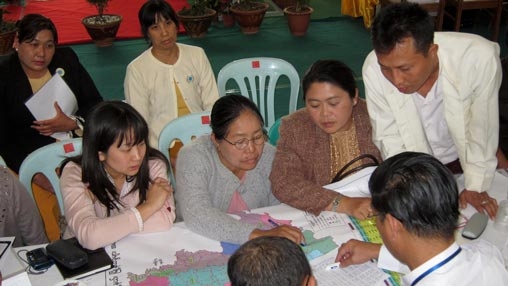Reflecting its commitment to reach out and listen to the people, the Government of Myanmar consulted with large groups of stakeholders to select the first three townships that will participate in the National Community Driven Development Project.
The selected townships are Kanpetlet in Chin State, Namhsan (Pa Laung Self-Administered Zone) in Shan State, and Kyunsu in Tanintharyi Region. The project will support all village tracts in each township, benefiting approximately 245,000 people in its first year of operation.
Going forward, consultations will be held at the community level in each of the three townships, where villagers will be empowered to choose, plan, build, monitor and account for small infrastructure projects to improve their lives.
The project’s main objective is to enable poor rural communities to benefit from improved access to and use of basic infrastructure and services through a people-centered approach. However, reliable data on poverty at the township level and below are scarce in Myanmar, making it difficult to prioritize the selection. In response to a suggestion by local civil society, the Government of Myanmar undertook consultations during February 2013 to discuss conditions on the ground and select the first three townships in which the project will operate.
Consultation workshops were held in Taunggyi (Shan State; February 14), Hakha (Chin State; February 26) and Dawei (Tanintharyi Region; February 27). In Taunggyi and Dawei, about 250 people participated, representing region/state government and parliament, ethnic groups, community-based organizations, civil society groups, local and international non-governmental organizations and development partners. In Hakha, almost 350 participants joined the workshop.
The process for selecting the participating townships consisted of three steps.
First, the Government invited civil society groups, non-governmental organizations, and development partners to participate in the event through wide networks. Those interested in joining received information prior to the workshops about the project and the selection process as well as a table summarizing available economic and social data for all townships in Chin State and Tanintharyi Region and all self-administered zones in Shan State.
Second, consultations were organized by the Department of Rural Development in cooperation with the region/state government. For each workshop, the morning session was dedicated to familiarizing participants with the project and seeking feedback on it. Short presentations were followed by lively discussions about a range of topics, from the general development situation in the region/state to specific project design parameters. For the afternoon session, participants were split into smaller groups, each with a mix of stakeholders, to discuss available data and share insights from their first-hand knowledge about the state of development in the townships – for instance, regarding food security, transportation, and livelihoods. Each group then ranked three townships according to the selection criteria which focus primarily on poverty, as well as absence of external funding and commitment by regional government to the objectives of the project. The results were aggregated and agreed upon in a final plenary session.
Third, the Chief Minister reviewed the three prioritized townships per region/state and submitted the proposed township to the Ministry of National Planning and Economic Development and the Ministry of Border Affairs for confirmation. Finally, the Foreign Aid Management Working Committee -- the central government committee charged with aid coordination -- selected the townships, and the World Bank, upon evaluating the selection process, provided its no-objection.
These consultation workshops, led by the Department of Rural Development have proven to be effective for selecting the poorest townships that will now participate in the project.
The three workshops reinforced the importance of listening to the views of stakeholders about the various dimensions of poverty in rural areas, disseminating the invitation to the workshops widely, allocating sufficient time for both plenary and group discussions, close collaboration between the union and region/state authorities for organizing the event, and providing a conducive atmosphere for an open dialogue involving different stakeholder groups.
The process will be refined and used in 2014 for the selection of five additional townships. The project will eventually operate in 15 townships – one in each of the country’s 14 regions and states as well as the union territory over six years.

